2 青岛海洋科学与技术试点国家实验室, 海洋地质过程与环境功能实验室, 山东 青岛 266237;
3 俄罗斯科学院远东分院太平洋海洋研究所, 俄罗斯 符拉迪沃斯托克 690041)
海冰由表层海水降温凝结而成,在全球中高纬海区广泛分布,面积可达全球海洋总面积的7 % [1]。海冰作为现代地球气候系统的一个基本要素,对海气之间的热交换和地球的太阳辐射收支具有重要影响。海冰形成引起的盐析过程可以增强水体的垂向对流,并有利于海洋中、深层水团的形成,进而影响海洋中的物质和能量分布和循环[2~4]。已有研究表明,高纬海冰变化影响亚洲季风强度[5~6]、热带辐合带的经向位移[7]和大西洋经向翻转环流(Atlantic Meridional Overturning Current,简称AMOC)的强度[2]。海冰还作为一种重要的地质营力而参与到中高纬海区的沉积过程中。与冰山等大型冰体一样,海冰可以搬运的沉积物颗粒小至粘土大至砾石,这些颗粒在海冰形成时被冻结固定,至消融时随浮冰漂移直到落入海底,被称为冰筏碎屑(Ice-Rafted Debris,简称IRD)[8]。
现今日本海西部海域发育季节性海冰,对日本海通风、深层水的形成和海盆尺度的生物地球化学过程具有重要的作用[9]。前人曾对日本海北部和东北部海冰形成演化历史开展了有限的研究。Ikehara[10]利用IRD(> 63 μm)重建了晚第四纪以来日本海东部海冰覆盖范围的演化历史,认为在末次冰盛期(约23~18 ka,Last Glacial Maximum,简称LGM)海冰可向南覆盖至Oga半岛(39°58.11′N),10 ka之后海冰覆盖范围快速向北收缩。Gorbarenko等[11]发现日本海北部海冰快速响应Blling-Allerd间冰阶,15 ka之后海冰快速消退。Ikehara和Itaki[12]发现日本海北部记录的IRD峰值与南部深层水指示种Cycladophora davisiana丰度高值并不完全对应,表明南北海区间海冰形成与通风过程可能并不同步。总体来讲,由于缺乏沉积岩芯,长期以来对于日本海西部海冰覆盖历史的报道还十分少见,并且对于海冰形成与底层流体演化之间的耦合关系仍然不清楚。
现代日本海仍发育季节性海冰,主要出现在12月至次年3月,分布在北部的鞑靼海峡和西侧的彼得大帝湾[13]。前人调查发现其覆盖范围变化受西伯利亚高压强度和活动中心位置的控制[14],因此与东亚冬季风(East Asian Winter Monsoon,简称EAWM)强度关系密切。EAWM风向几乎垂直于日本海西岸,利于沿岸海冰的形成[13~14]。来自中国的黄土和红土记录表明,EAWM的形成始于中新世[15],并存在轨道和千年时间尺度上的变化模式[16~19],其强度在末次冰盛期和冰消期早期显著增加[20]。除了黄土沉积,大量来自中国海的沉积记录也被用于重建末次冰消期以来EAWM的演化过程[21~24]。Wang等[25]将湖光岩玛珥湖硅藻Aulacoseira granulata与Cyclotella stelligera的比值(AG/CS)作为EAWM的指标,结果显示EAWM强度在晚冰消期-早全新世增强,并在轨道尺度上与东亚夏季风(East Asian Summer Monsoon,简称EASM)同相位变化。
日本海作为西太平洋的边缘海之一,位于东亚季风下垫面(图 1)。冰期随着全球变冷和EAWM强度增加,日本海海冰覆盖范围必然显著增加。沉积物粒径是搬运介质动力强弱的直接体现,已被广泛用于古环境重建[26~32]。本文分析了位于日本海西北部现代海冰影响和深层水生成区域的沉积岩芯LV53-18-2,采用沉积物粒径端元分析和相关性分析方法,确定了反映海冰和底流活动的粒径指标,重建了过去30.0~5.0 ka日本海西部海冰覆盖和底流活动历史,探讨了控制日本海海冰覆盖范围变化的因素。
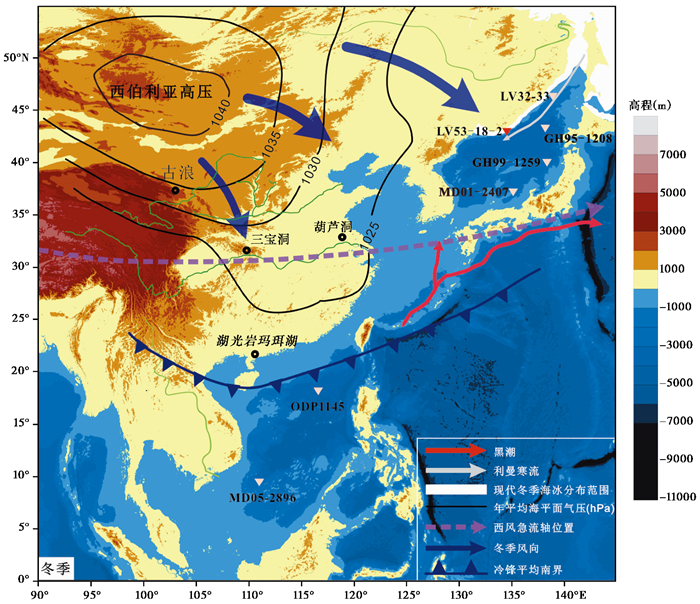
|
图 1 研究区域、站位、表层海洋环流和年均海平面气压示意图[25]现代冬季海冰覆盖范围参考文献[11, 13] Fig. 1 A schematic diagram of study site, surface ocean circulation and mean annual sea-level pressure in the study area[25], and the modern sea ice coverage refers to references[11, 13] |
日本海是西北太平洋封闭程度最高的一个边缘海[33],通过4个较浅的海峡与外海进行水体交换,北部鞑靼海峡最浅,仅约15 m,最深的对马海峡也只有130 m[34]。在冰期-间冰期旋回及海平面波动幅度巨大的背景下,其海洋环境和沉积过程明显受到海平面变化的控制[35~38]。
日本海发育逆时针表层环流系统[39]。对马暖流(Tsushima Warm Current,简称TWC)作为唯一流入日本海的暖流,是影响现代日本海海洋环境的一个主控因素[40]。TWC经过对马海峡沿本州岛向北流,分别通过津轻海峡和宗谷海峡流入北太平洋和鄂霍次克海。利曼寒流(Liman Cold Current,简称LCC)自鞑靼海峡沿日本海西岸南下,在约40°N向东偏转与TWC相遇,形成亚极地锋面。日本海还是北太平洋唯一发育深层水的边缘海[41]。冬季受西伯利亚寒流影响,日本海西北部发育大量海冰,盐析作用导致表层海水变重下沉,形成了日本海深层水[42],这一特征导致日本海深层水氧含量高于北太平洋[43]。深层水的形成不仅控制日本海的水团通风和组成,还影响着生源要素的生物地球化学循环和海底的沉积环境[44]。
日本海周围没有大河输入陆源物质[45],海冰和EAWM/西风是影响陆源碎屑输运到日本海的主要方式[46]。环日本海的活火山也贡献火山物质到日本海不同区域[47]。在海洋里,陆源碎屑物质的分布进一步受到TWC和LCC的改造。受这些地质营力的强度、影响范围及他们之间相互作用的制约,在空间分布上,日本海陆源碎屑物质的来源和累积存在显著差异。日本海南部海盆陆源碎屑物质主要来自中韩河流贡献[48~49],在日本海中部存在显著的风尘输运[28, 50],在日本海北部发育明显的冰筏沉积[10]。
日本海最显著的一个沉积特征是广泛发育亮色-暗色交替的纹层沉积,并呈现千年尺度变化模式。已有的研究认为这与海平面、EASM、底层水通风及含氧量变化密切相关[51~52]。
2 材料与方法 2.1 研究材料LV53-18-2岩芯(42°56′N,134°44′E)位于日本海西部俄罗斯滨海边疆区岸外30 km(见图 1),水深551 m,岩芯长393 cm,为2010年中俄首次日本海联合航次期间采集。岩芯沉积物总体以灰绿、灰褐色粉砂为主(图 2),上部0~144 cm为砂质粉砂,中部145~236 cm以粉砂为主,中间存在一个20 cm的砂质粉砂夹层,下部237~393 cm以砂质粉砂为主,夹杂零星粉砂层[53]。按1 cm间隔分样,共采得沉积物样品393个。
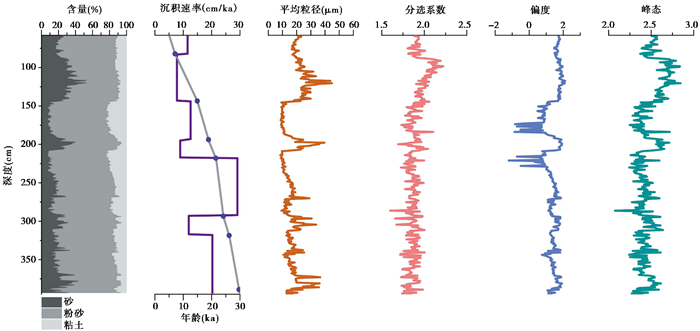
|
图 2 LV53-18-2岩芯沉积物组成、线性沉积速率、年龄-深度关系和相关的粒度参数剖面图 蓝色点代表光释光(OSL)年龄控制点[53] Fig. 2 Downcore profiles of sediment components, linear sedimentation rate, depth-age relationship and associated grain-size parameters of core LV53-18-2, and blue dots are dating of OSL[53] |
使用15 %的H2O2和10 %的稀盐酸先后浸泡12 h,分别除去样品有机质和碳酸盐,然后加入Milli-Q水清洗,超声后上机测试。粒度分析所用仪器为英国马尔文公司Mastersizer2000型激光粒度仪,测量范围为0.02~2000 μm。粒级分辨率为0.01 ϕ,重复测量的相对误差 < 3 %。该分析测试在自然资源部海洋地质与成矿作用重点实验室完成。
2.3 年龄模型及线性沉积速率该岩芯年龄模型由光释光测年确定[53]。具体方法是挑选82 cm、143 cm、153 cm、193 cm、217 cm、292 cm、317 cm和393 cm共8个层位样品进行了光释光测年。用湿筛法筛取 < 38 μm的细粒组分,用10 %的盐酸(HCl)和30 %的双氧水(H2O2)去除碳酸盐和有机质,然后根据斯托克斯定律进行样品的矿物分离[54]。分离后在氟硅酸中浸泡3~4 d后得到纯石英用以测年,岩芯底部年龄为30.02 ka。实验在中国科学院南京地理与湖泊研究所光释光测年实验室进行。采用线性内插法计算年龄控制点间岩芯的沉积速率。总体上以217 cm(21.6 ka)层位为界,末次冰期沉积速率高于冰消期及全新世,最高达到29.1 cm/ka,18.9~15.0 ka沉积速率为12.59 cm/ka,15.0~7.1 ka沉积速率最低,仅为7.79 cm/ka,7.1 ka之后沉积速率为11.53 cm/ka(图 2)。
2.4 粒径端元分析Weltje和Prins[55~56]认为沉积物由不同来源或动力过程的组分混合而成,其粒度数据呈现出的多峰形态往往可以分离为不同端元(End member,简称EM),因此提出了端元分析模型以有效区分不同物源或者不同的输运机制。Paterson和Heslop[57]在此基础上基于Matlab软件进行了改进。本文利用Matlab平台开发的程序AnalySize对研究样品进行端元分析。导入粒度数据后,在端元数1~10的基础上采用Gen. Weibull函数进行拟合[57],在端元数尽量小的前提下,粒级复相关系数R2越接近1及角度偏差越小的拟合能更好地满足要求。
2.5 可分选粉砂百分比和平均粒径计算方法根据McCave等[58]的方法,计算了可分选粉砂(Sortable Silt,简称


|
(1) |
公式(1)中,i为10~63 μm中每个数据框的边界值,(i)指定与i对应的数据框,A为10~63 μm中每个数据框的几何中值,V %为10~63 μm中每个数据框的百分含量[59]。
2.6 质量累积速率的计算EM3的质量积累速率(Mass Accumulation Rate,简称MAR,单位g/(cm2 ·ka))计算公式如下:

|
(2) |
公式(2)中,LSR为线性沉积速率(Linear Sedimentation Rate,单位cm/ka),DBD为全样干密度(Dry Bulk Density,单位g/cm3),EM3 %为端元3的含量[60]。
3 结果 3.1 沉积物粒度参数和粒径分布图 2显示,沉积物不同层位中砂含量在10 % ~20 %左右,在70~150 cm和约200 cm处出现高值,平均粒径和峰度的变化与砂含量变化几乎一致。分选系数介于1.5~2.0,反映沉积物分选较差。偏度几乎均呈现正偏,表明沉积物中粗组分含量较多。
LV53-18-2岩芯粒径-频率分布曲线在大多数时段呈现非正态分布,表明其受到多种因素的影响(图 3)。除HS(Heinrich Stadial)1(约17.5~15.0 ka),粗颗粒的峰值在其他研究时段都非常显著,晚冰消期粗颗粒的含量比LGM和中全新世更高,曲线峰度也更大;HS1时期的粒径-频率曲线呈现以10 μm为轴的正态分布,表明沉积物来源或者沉积动力条件与其他时段存在显著差异。
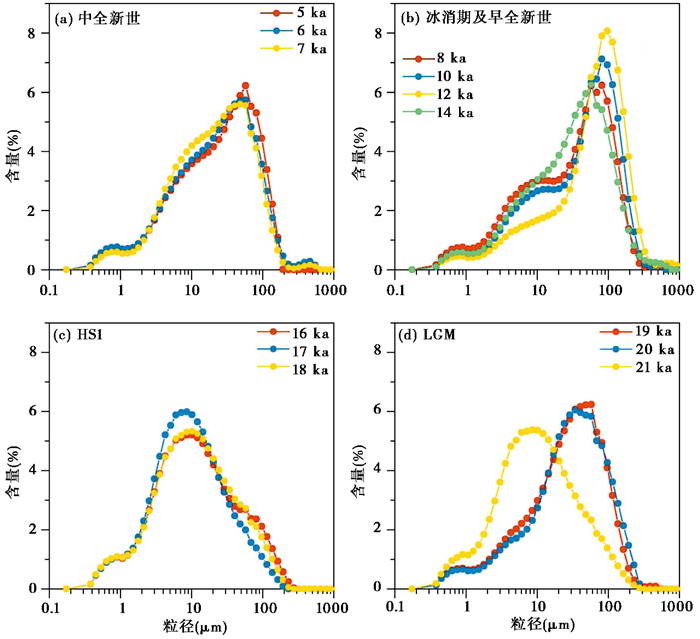
|
图 3 典型时段沉积物粒径频率分布曲线 Fig. 3 Distribution of sediment grain-size of frequency in typical intervals |
粒度数据计算结果(图 4)显示,端元数为1~6时复相关系数R2分别为0.765、0.968、0.9863、0.994、0.997和0.998,角度偏差逐渐降低。从对数据拟合的程度来看,粒径端元数为3时,已经能较好地代表粒度数据的总体特征,因此本文选取这3个端元对粒度数据进行分析。
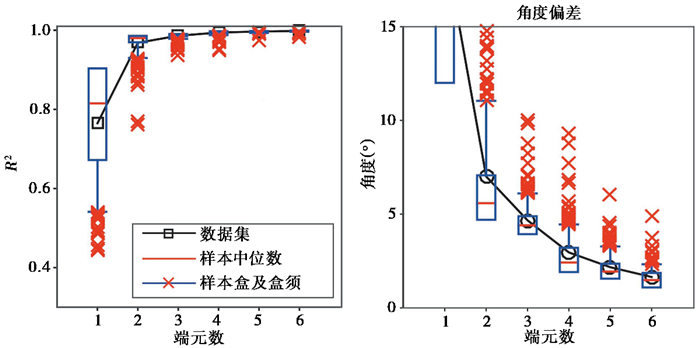
|
图 4 端元划分的线性相关和角度偏差 Fig. 4 Linear correlation and angular deviation of end members |
粒径端元结果(图 5和表 1),EM1、EM2和EM3均呈单峰且接近正态分布。EM1的峰值主要集中在2~20 μm,平均粒径为8.68 μm,百分含量介于11.98 % ~94.20 %,平均值为54.3 %;EM2的峰值主要集中在20~80 μm,平均粒径为37.81 μm,百分含量介于0~73.62 %,平均值为27.3 %;EM3的峰值集中40~160 μm,平均粒径为75.77 μm,百分含量介于0~76 %,平均值为18.4 %。
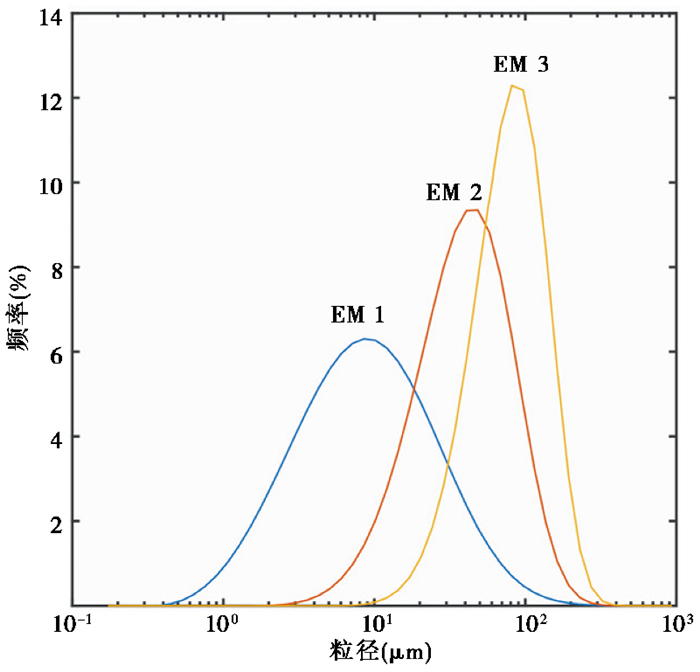
|
图 5 模拟的沉积物粒径端元频率分布图 Fig. 5 Distribution of modeled sediment grain size of frequency |
| 表 1 LV53-18-2沉积物粒径各端元参数特征 Table 1 Characteristics of the sediment grain-size of modeled end member of core LV-18-2 |
日本海沉积物中陆源碎屑物质累积与风力(EAWM、西风)、水动力(河流、洋流)和海冰密切相关,不同搬运方式的搬运能力存在显著差异[46]。海冰可以搬运粗颗粒物质,前人将日本海砂粒级以上沉积颗粒视为海冰搬运[10~11]。河流搬运的粗颗粒物质大都在河口区沉积,对日本海半远洋沉积物的贡献只存在细颗粒部分[46]。日本海位于EAWM和西风环流下风区,风尘物质是日本海沉积物中的一个重要组成部分[61~63],一般认为大于16 μm的粉尘难以被长距离搬运[64],日本海中部西风风尘中值粒径大约为7~15 μm[28, 32]。洋流对沉积物的搬运能力取决于流速与颗粒沉降速率,而沉降速率与颗粒粒径成正比,因此洋流难以长距离搬运粗颗粒物质[65]。前已述及,LV53-18-2岩芯中粒度变化中存在3个主要端元,每个端元的变化可能受控于不同的动力条件。根据端元粒径特征和含量以及不同介质的搬运能力,下面对各粒径端元代表的动力条件进行分析。
EM1介于2~20 μm,主要由细粉砂构成。现代调查显示日本海200~300 m以下水体性质非常均一,以低温高氧为特征,反映水体通风非常活跃[9],虽然研究区水深较浅,但位于海冰活动和深层水形成区域[66],沉积物很容易受到底流分选影响,底流增强会移除细粒组分,导致该粒级范围内粗颗粒含量升高和平均粒径增大。EM1端元高值主要出现在LGM前期和HS1,在LGM后期和15.0 ka之后则呈现低值(图 6a)。
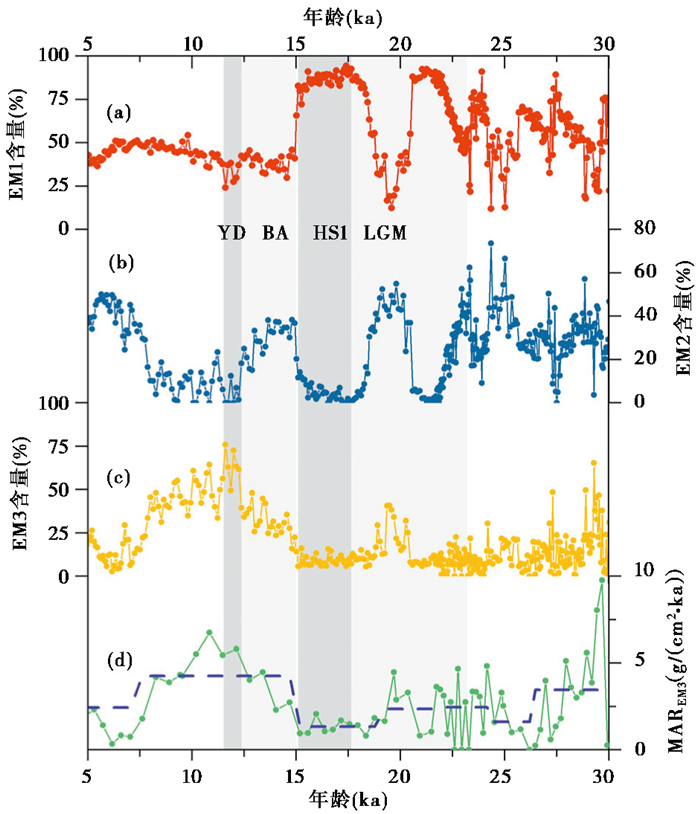
|
图 6 模拟的3个沉积物粒径端元含量时间序列(a~c)、EM3质量累计速率(MAR)及其平均值曲线(d) YD:新仙女木事件(Younger Dryas,12.9~11.7 ka);BA:波令-阿勒罗德间冰阶(Bølling-Allerd,14.7~12.9 ka);HS1:海因里希冰阶1期(Heinrich Stadial 1,17.5~15 ka);LGM:末次冰盛期(Last Glacial Maximum,23~18 ka) Fig. 6 Time series of contents of three modeled grain-size end members(a~c), the mass accumulation rates(MAR)and its mean value of EM3(d) |
EM2 (20~80 μm)主要包括细砂和粗粉砂,其粒径范围与EM1、EM3有部分重合,含量变化可能受到底流和IRD等多种因素的影响(图 6b),15.0 ka前EM2含量与EM1呈明显的反向波动,而15.0 ka之后则与EM3的输入量大致呈反向变化。
EM3端元介于40~160 μm,主要由粗粉砂和砂构成,含量和MAR高值主要出现在15.0~7.8 ka(图 6c和6d)。我们认为EM3含量指示研究区海冰活动程度,原因包括:1)风力、洋流等搬运介质难以长距离搬运粗颗粒沉积物[65],研究区虽离岸较近,但不存在大型河流[45];2)卫星观测显示现代日本海西岸冬季仍存在海冰覆盖[13],且发育广泛的冰筏沉积;3)前人对日本海IRD的研究中,大于63 μm颗粒含量可以作为指示海冰活动的指标[10~11]。因此我们认为EM3主要指示海冰活动强弱。
另一方面,为了验证提取的底流指标的可靠性,我们计算了样品的







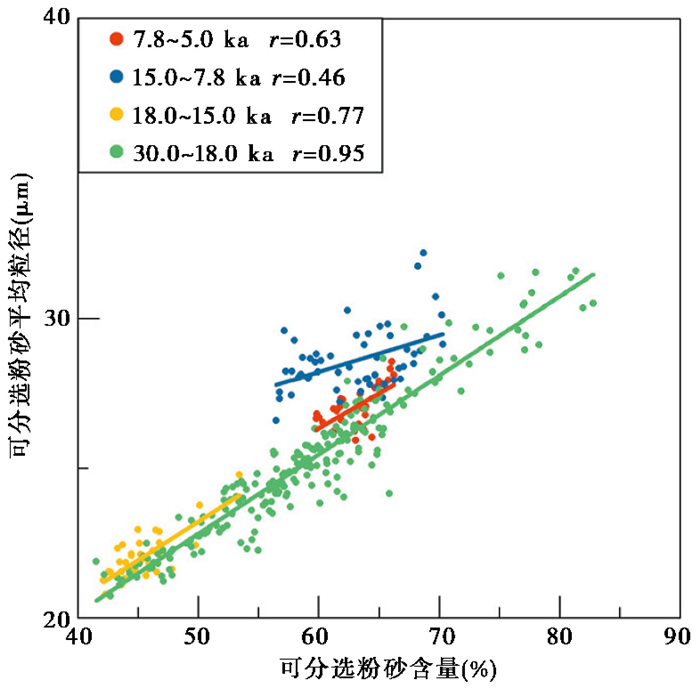
|
图 7 可分选粉砂含量与平均粒径相关性图解 Fig. 7 The scatter plot of correlation between content and mean grain size of sortable silt |
前已述及,受日本海地形地貌制约,日本海周边陆地河流不能直接将粗碎屑沉积物输运到研究区。其他地质营力,如风和洋流又难以长距离搬运粗颗粒组分。LV53-18-2岩芯沉积物粒径端元分析表明,EM3(40~160 μm)主要由粗粉砂和砂构成,在本研究中指示海冰活动。现今日本海西部仍发育季节性海冰,并与日本海西部砾石和砂质沉积物类型相对应[68],进一步支持我们的推断。需要指出的是,海冰不仅搬动粗组分也携带细粒组分,因此在本研究中粗碎屑组分是对海冰活动变化的保守估计。
IRD沉积是冬季海冰形成和春/夏季融化的综合反映[12]。冬季EAWM盛行时,日本海西部表层海水温度急剧减小,促使海冰形成并向远岸扩张[10]。春季随着欧亚大陆快速增温,EAWM减弱[69],海冰随之消融。在冷期时段,如Heinrich冰阶,夏季海水温度显著下降不利于海冰融化,出现常年海冰覆盖的现象,导致下覆沉积物中出现低IRD沉积甚至不含IRD[10]。
为了揭示控制日本海西部海冰活动的影响因素,我们的记录与北半球高纬太阳辐射[70]、EASM指标[71]、海平面[72]、EAWM指标[25, 73]和日本海区域IRD记录[11~12]进行比较(图 8a~8k)。EM3含量显示,30.0 ka以来研究区持续受到季节性海冰覆盖的影响(图 8i)。高IRD含量主要出现在末次冰消期晚期-中全新世早期(15.0~7.8 ka),而在末次冰期、冰盛期和中晚全新世IRD含量减小,HS1期间IRD含量显著降低。在末次冰期,随着高纬夏季日射量降低(图 8a),北极冰盖扩张导致欧亚大陆降温,西伯利亚和蒙古高压变强,增强了EAWM[69];另一方面,随着全球海平面逐渐下降(图 8c),东海陆架大面积暴露,黑潮主流轴路径发生迁移,抑制了TWC入侵日本海[51~52, 74]。增强的EAWM和减弱的TWC暖水入侵都有利于日本海表层海水温度减小,促进日本海西部海冰覆盖范围扩张[75]。EM3含量显示30~18 ka海冰活动存在减弱趋势,北部的LV32-33岩芯IRD(> 63 μm)指标含量在此时段一直处于低值(图 8h),表明在末次冰期-冰盛期寒冷气候条件下,日本海西部和北部季节性海冰活动是微弱的。南部GH99-1259岩芯在MIS 3晚期和MIS 2期的IRD含量增加,而北部GH95-1208岩芯(砾石个数/cm3)的IRD含量却显著减小(图 8g)[10, 12],Ikehara[10]认为这反映了寒冷气候导致海冰覆盖扩张和融冰前缘南移,短暂的峰值可能与千年尺度冷事件(HS2,约24 ka)有关[12]。值得注意的是西部海冰活动在LGM晚期突然活跃,我们推测当时EASM较强[76]、带来更多水气和热量,促进了春/夏季海冰融化(图 8b)。
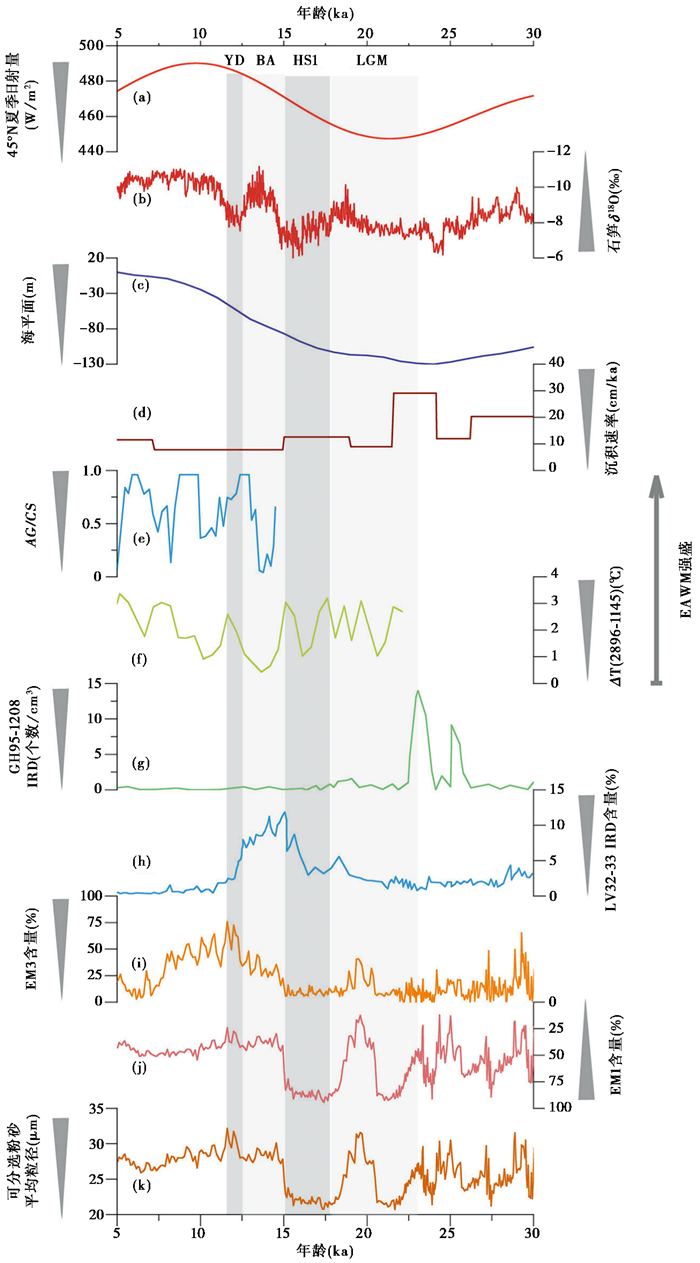
|
图 8 代用指标时间序列记录比较 (a)45°N日射量曲线[70]、(b)中国石笋氧同位素曲线[71]、(c)相对海平面变化曲线[72]、(d)LV53-18-2沉积速率(LSR)曲线、(e)湖光岩玛珥湖A.granulata与C.stelligera比值(AG/CS)指示的EAWM强度[25]、(f)南海南部MD05-2896和北部ODP1145站位表层海水温度经向梯度[73]、(g)GH95-1208冰筏碎屑记录[12]、(h)LV32-33冰筏碎屑记录[11]、(i)LV53-18-2冰筏碎屑含量、(j)LV53-18-2 EM1含量变化曲线和(k)可分选粉砂平均粒径变化曲线 Fig. 8 Comparison of time series of proxy records. (a) June insolation at 45°N[70], (b)δ 18O in Chinese cave stalagmites[71], (c)eustatic sea level change[72], (d)linear sedimentation rate of LV53-18-2, (e)the ratio (AG/CS)between A.granulata to C. stelligera from the Huguang Maar Lake[25], (f)meridional temperature gradient of surface water between MD05-2896 in the Southern China Sea and ODP 1145 in the Northern China Sea[73], (g)variations in IRD content of GH95-1208[12], (h)variations in IRD content of LV32-33[11], (i)variations in IRD content of LV53-18-2, (j)variations in content of EM1 and (k) sortable silt mean size of LV53-18-2 |
在HS1时期,IRD含量显著减小可能反映海冰覆盖的两种状态:1)研究区被更长时间海冰覆盖(甚至存在常年海冰覆盖);2)研究区在此时段几乎不存在海冰覆盖。我们倾向于第一种状态,证据如下:第一,日本海MD01-2407、MD01-2408岩芯的不饱和烯酮温度指示HS1期海表层温度显著降低[77];第二,Ikehara[10]发现末次冰消期日本海东部融冰前缘仍在42°N以南,表明日本海气温非常寒冷;第三,东亚黄土平均粒径[31, 78]和中国东部洞穴石笋记录[76, 79]表明,由于大量冰川融水涌入北大西洋导致北半球气候快速变冷[80],EAWM显著增强,EASM减弱。这些证据表明在HS1时期,EAWM强盛、日本海海表温度降低有助于增加海冰覆盖时长,IRD含量出现异常低值很可能与常年冰出现有关。
在15.0~7.8 ka,EM3的含量和MAR达到30.0 ka以来峰值(图 6c和6d),表明此时段海冰活动显著增强,带来大量IRD沉积。日本海北部的LV32-33岩芯中IRD含量在15.0 ka左右出现高值[11](图 8h)。模拟结果[81~82]和代用指标记录[25, 73, 83~84]显示轨道尺度上EAWM在15.0~6.0 ka时段强盛,有利于海冰在日本海西部形成。15.0 ka以来,随着高纬太阳辐射量增加[70](图 8a),两极冰盖开始消融[85],海平面快速上升[72](图 8c),日本海与周围海域水体交换增多。与此同时,EASM增强(图 8b),也为日本海带来更多的降水和热量,导致日本海水增温[77],这些条件均有利于春/夏季海冰融化。在此时段,LV53-18-2和LV32-33岩芯中IRD含量显著增加是冬季海冰覆盖扩张和春/夏季有利的融冰条件共同作用所致,但LV32-33融冰过程仅持续至13.0 ka左右,这种差异可能体现了该岩芯比LV53-18-2距日本海西岸更远,粗碎屑供给相对不足;GH95-1208在15.0~7.8 ka并未出现大量IRD沉积(图 8g),除了粗碎屑供给不足,还可能受到融冰前缘迅速撤退的影响[75]。需要指出的是,LV53-18-2在YD时段出现了粗碎屑的最高值,表明日本海冬季海冰活动急剧增强,这与此时段强EAWM相对应[73, 86],而在EAWM同样盛行的HS1时段,IRD沉积却异常微弱,反映日本海海洋环境在HS1和YD时段存在显著差异,我们推测这与全球海平面变化相关。全球海平面自LGM后开始上升,但是受日本海4个浅海峡制约(最大海槛深度130 m),HS1时期日本海与周边海洋水体交换仍然十分有限,而YD时段全球海平面上升至55 m[72],这必然增加周围大洋温暖水体入侵日本海的体量,提高日本海表层海水温度和热含量,有利于夏季海冰融化。7.8 ka以来,研究区IRD含量迅速降低。全球海平面在8 ka左右达到现今水平(图 8c)[72],TWC自8.5 ka以来也发育成熟并入侵日本海[87],增加了日本海水体热含量;另一方面,随着北半球高纬太阳辐射量下降[70](图 8a),EAWM强度也逐渐减弱[82~84],上述因素共同导致日本海西部海冰活动减弱。
综上所述,日本海西部沉积物IRD含量指标研究区海冰活动十分剧烈,受冬季海冰形成、春/夏季融化时海洋与大气条件共同制约,主要是受北半球高纬太阳辐射、EAWM和海平面之间的相互作用控制。在低海平面时期(30.0~15.0 ka),EAWM强盛、夏季太阳辐射减小,利于海冰生成而不利于海冰融化,海冰活动减弱,甚至存在常年海冰发育(HS1);当海平面较高时(15.0~7.8 ka),相对温暖的大洋水体入侵日本海,提高日本海水体的热含量和海表温度,促进海冰融化,同时EAWM强盛和增加的夏季太阳辐射,使日本海西部季节性海冰活动非常活跃,得到沉积物中高IRD含量证实;在高海平面时期(7.8 ka以来),EAWM减弱和TWC入侵使日本海整体热含量升高,不利于海冰生成,日本海西部季节性海冰活动显著减弱。
4.3 日本海海冰活动与深层水演化的关系日本海深水环流的形成与冬季海冰形成和盐析作用导致的表层水冷却下沉有关[14]。Talley和Lynne[9]观测,在1999年至2001年,表层水冷却下沉区域主要位于日本海西北部。基于浮游有孔虫丰度、碳氧同位素和沉积结构等参数,Domitsu和Oda[87]指出现代日本海深水环流可能始于9.3 ka;Minoura等[66]认为在高海平面时期,日本海深层水主要由以TWC为主体的水冷却下沉而成,低海平面时期亲潮也存在显著贡献;基于沉积物磁学参数,葛淑兰等[88]认为日本海底层流方向在冰期-间冰期和转型时期发生了显著变化,末次冰消期底流流速明显增大;Tada等[89]认为日本海盆500 m以深普遍发育暗色层,并且各标志层年代上具有很好的对应关系。LV53-18-2岩芯未见暗色沉积层发育,这与该岩芯位于日本海深层水形成区域,且一直处于良好通风状态有关[38],表明日本海不同区域海洋沉积环境存在显著差异。
沉积物








底流指标显示30.0 ka以来研究区底流强度呈现千年尺度波动,在HS1时段底流强度显著降低,而在LGM晚期和7.8 ka之后底流强度增强(图 8j和8k),与LSR呈现较好的反向波动(图 8d)。这一结果与前人对南部和东部的研究结果并不一致[90~91]。前人研究指出,受海平面下降和淡水层化影响,LGM时期日本海南部、北部和东部海域均发育指示水体停滞环境的暗色纹层沉积[51, 90~91],为静海相沉积条件,而我们的结果显示日本海西北部海域在LGM后期底流突然活跃,在此时段IRD含量增加,这与EAWM增强驱动的海冰覆盖扩张和盐析增加促进了深层水形成有关,说明日本海的环境在不同区域或不同水深存在显著的差异。
HS1期间,AMOC减弱和向北半球跨赤道热量输运显著减小,导致北半球海冰和降雪覆盖范围扩大,提高了EAWM强度[78],增强的EAWM将有助于海冰扩张和深层水的形成,但在此时段我们的数据表明深层水形成明显减弱。这可能是研究区被常年海冰覆盖,抑制了深层水的形成,这也与低IRD含量相对应。7.8 ka以来底流活动增强,这与高盐TWC入侵日本海同步[89],表明TWC不仅影响日本海表层水文特征,也对日本海底流活动施加重要的影响。
5 结论对位于日本海西部LV53-18-2岩芯沉积物中的粒度数据进行了分析,采用粒径端元分析方法和可选粉砂平均粒径,重建了过去30.0~5.0 ka以来日本海西部海冰活动和底流演化历史,并分析了控制日本海海冰变化的主要控制因素,主要认识如下:
(1) 粒径端元显示,在LV53-18-2沉积岩芯中存在3个粒径端元:EM1 (2~20 μm)、EM2 (20~80 μm)和EM3 (40~160 μm)。其中,EM3含量变化指示海冰活动强度。EM1含量结合
(2) 3万年以来日本海西部海冰活动发生了剧烈变化。在末次冰期-冰盛期(30.0~18.0 ka),日本海西部季节性海冰活动减弱。末次冰消期晚期-中全新世早期(15.0~7.8 ka)海冰活动非常活跃,中晚全新世(7.8~5.0 ka),研究区季节性海冰活动显著减弱。HS1时期研究区可能被常年海冰覆盖。日本海底流活动与海冰活动密切相关,在季节性海冰形成活跃时期,底流活动显著增强,常年海冰存在时期底流活动明显减弱。
(3) 日本海西部IRD沉积受冬季海冰形成和春/夏季海冰融化时的条件共同制约,实际上与高纬太阳辐射、EAWM强度和全球海平面变化密切相关。在末次冰期-冰盛期(30.0~18.0 ka)低海平面时,强盛的EAWM非常利于海冰的形成,而北半球夏季太阳低辐射量和较低的海水温度不利于海冰融化,导致海冰活动有减弱趋势。在末次冰消期晚期-中全新世早期(15.0~7.8 ka),EAWM依然强盛,增加的北半球夏季太阳辐射和夏季海表温度,增强了日本海西部季节性海冰活动;7.8 ka以来,随着海平面接近现代水平,TWC入侵日本海的同时EAWM强度减弱,抑制了日本海西部海冰活动。在HS1时段,受AMOC减缓的影响,EAWM显著强化,而夏季太阳辐射和海平面都位于低值,导致研究区被常年海冰覆盖。
致谢: 感谢两位审稿专家和编辑部杨美芳老师提出的宝贵修改意见和建议,使本文的结构和质量得到很大提高。
| [1] |
Wilford F W, Serena S. Sea ice: Overview[M]//Cochran J K, Bokuniewicz H J, Yager P L. Encyclopedia of Ocean Sciences. Amsterdam: Elsevier Academic Press, 2019: 1-6.
|
| [2] |
Broecker W S. Paleocean circulation during the last deglaciation:A bipolar seesaw?[J]. Paleoceanography, 1998, 13(2): 119-121. DOI:10.1029/97PA03707 |
| [3] |
Abelmann A, Gersonde R, Knorr G, et al. The seasonal sea-ice zone in the glacial Southern Ocean as a carbon sink[J]. Nature Communications, 2015, 6(1): 1-13. |
| [4] |
Marzocchi A, Jansen M F. Connecting Antarctic sea ice to deep-ocean circulation in modern and glacial climate simulations[J]. Geophysical Research Letters, 2017, 44(12): 6286-6295. DOI:10.1002/2017GL073936 |
| [5] |
Nair A, Mohan R, Crosta X, et al. Southern Ocean sea ice and frontal changes during the Late Quaternary and their linkages to Asian summer monsoon[J]. Quaternary Science Reviews, 2019, 213: 93-104. DOI:10.1016/j.quascirev.2019.04.007 |
| [6] |
Zhao P, Zhang X, Zhou X, et al. The sea ice extent anomaly in the North Pacific and its impact on the East Asian Summer Monsoon rainfall[J]. Journal of Climate, 2004, 17(17): 3434-3447. DOI:10.1175/1520-0442(2004)017<3434:TSIEAI>2.0.CO;2 |
| [7] |
Chiang J C H, Bitz C M. Influence of high latitude ice cover on the marine Intertropical Convergence Zone[J]. Climate Dynamics, 2005, 25(5): 477-496. DOI:10.1007/s00382-005-0040-5 |
| [8] |
Bond G, Heinrich H, Broecker W S, et al. Evidence for massive discharges of icebergs into the North Atlantic Ocean during the last glacial period[J]. Nature, 1992, 360(6401): 245-249. DOI:10.1038/360245a0 |
| [9] |
Talley, Lynne D. Deep convection and brine rejection in the Japan Sea[J]. Geophysical Research Letters, 2003, 30(4): 385-397. |
| [10] |
Ikehara K. Late Quaternary seasonal sea-ice history of the Northeastern Japan Sea[J]. Journal of Oceanography, 2003, 59(5): 585-593. DOI:10.1023/B:JOCE.0000009588.49944.3d |
| [11] |
Gorbarenko S A, Nam S I, Rybiakova Y V, et al. High resolution climate and environmental changes of the northern Japan(East) Sea for the last 40 kyr inferred from sedimentary geochemical and pollen data[J]. Palaeogeography, Palaeoclimatology, Palaeoecology, 2014, 414: 260-272. DOI:10.1016/j.palaeo.2014.09.001 |
| [12] |
Ikehara K, Itaki T. Millennial-scale fluctuations in seasonal sea-ice and deep-water formation in the Japan Sea during the Late Quaternary[J]. Palaeogeography, Palaeoclimatology, Palaeoecology, 2007, 247(1): 131-143. |
| [13] |
Park K A, Kim K, Cornillon P C, et al. Relationship between satellite-observed cold water along the Primorye coast and sea ice in the East Sea (the Sea of Japan)[J]. Geophysical Research Letters, 2006, 33(10): 229-237. |
| [14] |
Nihashi S, Ohshima K I, Saitoh S I. Sea-ice production in the northern Japan Sea[J]. Deep-Sea Research Part Ⅰ:Oceanographic Research Papers, 2017, 127: 65-76. DOI:10.1016/j.dsr.2017.08.003 |
| [15] |
Guo Z T, Ruddiman W F, Hao Q Z, et al. Onset of Asian desertification by 22 Myr ago inferred from loess deposits in China[J]. Nature, 2002, 416(6877): 159-163. DOI:10.1038/416159a |
| [16] |
Ding Z L, Derbyshire E, Yang S L, et al. Stacked 2.6-Ma grain size record from the Chinese loess based on five sections and correlation with the deep-sea δ18O record[J]. Paleoceanography and Paleoclimatology, 2002, 17(3): 1-21. |
| [17] |
An Z S. The history and variability of the East Asian paleomonsoon climate[J]. Quaternary Science Reviews, 2000, 19(1): 171-187. |
| [18] |
黄颖, 朱丽东, 张晓, 等. 庐山北麓JL红土剖面粉砂粒级元素地球化学特征及其物源意义[J]. 第四纪研究, 2019, 39(5): 1092-1102. Huang Ying, Zhu Lidong, Zhang Xiao, et al. Geochemical characteristics and their provenance implications of the silt fraction from JL red earth section in Lushan region, Jiujiang, South China[J]. Quaternary Sciences, 2019, 39(5): 1092-1102. |
| [19] |
郭飞, 王婷, 刘宇明, 等. 临夏黄土记录的26万年来季风快速变化[J]. 第四纪研究, 2019, 39(3): 557-564. Guo Fei, Wang Ting, Liu Yuming, et al. Rapid Asian monsoon changes recorded by loess depositions in Linxia since 260 ka B. P.[J]. Quaternary Sciences, 2019, 39(3): 557-564. |
| [20] |
Sun Y B, Clemens S C, Morrill C, et al. Influence of Atlantic meridional overturning circulation on the East Asian winter monsoon[J]. Nature Geoscience, 2012, 5(1): 46-49. DOI:10.1038/ngeo1326 |
| [21] |
Xiao S B, Li A C, Liu J P, et al. Coherence between solar activity and the East Asian winter monsoon variability in the past 8000 years from Yangtze River-derived mud in the East China Sea[J]. Palaeogeography, Palaeoclimatology, Palaeoecology, 2006, 237(2): 293-304. |
| [22] |
刘志飞, 赵玉龙, 王轶婕, 等. 南海第四纪东亚季风演化的粘土矿物指标[J]. 第四纪研究, 2017, 37(5): 921-933. Liu Zhifei, Zhao Yulong, Wang Yijie, et al. Clay mineralogical proxy of the East Asian monsoon evolution during the Quaternary in the South China Sea[J]. Quaternary Sciences, 2017, 37(5): 921-933. |
| [23] |
王海粟, 党皓文, 翦知盡. 中更新世转型时期南海北部上层水体结构演化特征——ODP1146站浮游有孔虫稳定同位素记录[J]. 第四纪研究, 2019, 39(2): 316-327. Wang Haisu, Dang Haowen, Jian Zhimin. Variations in the upper water structure of northern South China Sea during the mid-Pleistocene Climate Transition Period:Planktonic foraminifera oxygen isotope records of ODP site 1146[J]. Quaternary Sciences, 2019, 39(2): 316-327. |
| [24] |
涂路遥, 周鑫, 刘毅, 等. 近海泥质沉积物敏感粒径作为冬季风强度指标的再研究:与器测数据的对比[J]. 第四纪研究, 2015, 35(6): 1393-1400. Tu Luyao, Zhou Xin, Liu Yi, et al. Re analysis of sensitive grain size of coastal muddy sediments as proxy of winter monsoon strength:Comparison with instrumental data[J]. Quaternary Sciences, 2015, 35(6): 1393. |
| [25] |
Wang L, Li J J, Lu H Y, et al. The East Asian winter monsoon over the last 15, 000 years:Its links to high-latitudes and tropical climate systems and complex correlation to the summer monsoon[J]. Quaternary Science Reviews, 2012, 32: 131-142. DOI:10.1016/j.quascirev.2011.11.003 |
| [26] |
叶远达, 徐海, 蓝江湖, 等. 云南程海沉积物粒度对水深的指示意义[J]. 第四纪研究, 2018, 38(4): 1007-1016. Ye Yuanda, Xu Hai, Lan Jianghu, et al. Sedimentary grain size at Lake Chenghai, Yunnan Province:Indicator for water depth[J]. Quaternary Sciences, 2018, 38(4): 1007-1016. |
| [27] |
贾飞飞, 鲁瑞洁, 高尚玉. 毛乌素沙漠东南缘湖沼相沉积物粒度特征记录的12.2 cal.ka B. P.以来的区域环境变化[J]. 第四纪研究, 2018, 38(5): 1211-1220. Jia Feifei, Lu Ruijie, Gao Shangyu. Environmental changes recorded from grain-size characteristics of the lacustrine-peat sediments from southeastern margin of Mu Us Desert since 12.2 cal.ka B. P.[J]. Quaternary Sciences, 2018, 38(5): 1211-1220. |
| [28] |
Nagashima K, Tada R, Matsui H, et al. Orbital-and millennial-scale variations in Asian dust transport path to the Japan Sea[J]. Palaeogeography, Palaeoclimatology, Palaeoecology, 2007, 247(1): 144-161. |
| [29] |
李涛, 李高军. 斜度驱动第四纪冰期-间冰期转换——来自中国黄土的证据[J]. 第四纪研究, 2018, 38(5): 1111-1119. Li Tao, Li Gaojun. Obliquity pacing of deglaciations in the Pleistocene:Evidence from the Chinese loess deposits[J]. Quaternary Sciences, 2018, 38(5): 1111-1119. |
| [30] |
王婷, 龙宜澧, 刘星星, 等. 渭河盆地末次冰盛期以来沉积环境变化研究[J]. 第四纪研究, 2019, 39(3): 579-588. Wang Ting, Long Yili, Liu Xingxing, et al. Sedimentary environment evolutions in the Weihe Basin since Last Glacial Maximum[J]. Quaternary Sciences, 2019, 39(3): 579-588. |
| [31] |
杨石岭, 丁仲礼. 黄土高原黄土粒度的空间变化及其古环境意义[J]. 第四纪研究, 2017, 37(5): 934-944. Yang Shiling, Ding Zhongli. Spatial changes in grain size of loess deposits in the Chinese Loess Plateau and implications for palaeoenvironment[J]. Quaternary Sciences, 2017, 37(5): 934-944. |
| [32] |
董智, 石学法, 葛晨东, 等. 日本海中部60 ka以来的风尘沉积对西风环流演化的指示[J]. 科学通报, 2017, 62(11): 1172-1184. Dong Zhi, Shi Xuefa, Ge Chendong, et al. Evolution of westerly jet during the last 60 ka:Evidence from core deposits in the central Japan(East) Sea[J]. Chinese Science Bulletin, 2017, 62(11): 1172-1184. |
| [33] |
Wang P X. Response of Western Pacific marginal seas to glacial cycles:Paleoceanographic and sedimentological features[J]. Marine Geology, 1999, 156(1): 5-39. |
| [34] |
Oba T, Irino T. Sea level at the Last Glacial Maximum, constrained by oxygen isotopic curves of planktonic foraminifera in the Japan Sea[J]. Journal of Quaternary Science, 2012, 9(27): 941-947. |
| [35] |
Yao Z Q, Liu Y G, Shi X F, et al. Paleoenvironmental changes in the East/Japan Sea during the last 48 ka:Indications from high resolution X-ray fluorescence core scanning[J]. Journal of Quaternary Science, 2012, 27(9): 932-940. DOI:10.1002/jqs.2583 |
| [36] |
Zou J J, Shi X F, Liu Y G, et al. Reconstruction of environmental changes using a multi-proxy approach in the Ulleung Basin(Sea of Japan) over the last 48 ka[J]. Journal of Quaternary Science, 2012, 27(9): 891-900. DOI:10.1002/jqs.2578 |
| [37] |
邹建军, 石学法, 刘焱光, 等. 末次冰期以来日本海陆源沉积的地球化学记录及其对海平面和气候变化的响应[J]. 海洋地质与第四纪地质, 2010, 30(2): 75-86. Zou Jianjun, Shi Xuefa, Liu Yanguang, et al. Geochemical record of terrigenous sediments from the Sea of Japan since last glacial and its response to sea level and climate change[J]. Marine Geology & Quaternary Geology, 2010, 30(2): 75-86. |
| [38] |
石学法, 邹建军, 姚政权, 等. 日本海末次冰期以来沉积作用和环境演化及其控制要素[J]. 海洋地质与第四纪地质, 2019, 39(3): 1-11. Shi Xuefa, Zou Jianjun, Yao Zhengquan, et al. Sedimentation and environment evolution of the Sea of Japan since the Last Glaciation and its driving forces[J]. Marine Geology & Quaternary Geology, 2019, 39(3): 1-11. |
| [39] |
Yoon J H, Kim Y J. Review on the seasonal variation of the surface circulation in the Japan/East Sea[J]. Journal of Marine Systems, 2009, 78(2): 226-236. DOI:10.1016/j.jmarsys.2009.03.003 |
| [40] |
Yanagi T. Water, salt, phosphorus and nitrogen budgets of the Japan Sea[J]. Journal of Oceanography, 2002, 58(6): 797-804. DOI:10.1023/A:1022815027968 |
| [41] |
You Y, Suginohara N, Fukasawa M, et al. Transport of North Pacific intermediate water across Japanese WOCE sections[J]. Journal of Geophysical Research:Oceans, 2003, 108(C6). DOI:10.1029/2002JC001662 |
| [42] |
Tanaka K. Formation of bottom water and its variability in the northwestern part of the Sea of Japan[J]. Journal of Geophysical Research:Oceans, 2014, 119(3): 2081-2094. DOI:10.1002/2013JC009456 |
| [43] |
Chang Kyung-Il, Zhang Chang-Ik, Park Chul, et al. Oceanography of the East Sea(Japan Sea)[M]. Berlin: Springer International Publishing, 2016: 8-9.
|
| [44] |
Usami K, Ohi T, Hasegawa S, et al. Foraminiferal records of bottom-water oxygenation and surface-water productivity in the southern Japan Sea during 160-15 ka:Associations with insolation changes[J]. Marine Micropaleontology, 2013, 101: 10-27. DOI:10.1016/j.marmicro.2013.03.006 |
| [45] |
Milliman J D, Farnsworth K L. River Discharge to the Coastal Ocean:A Global Synthesis[M]. Cambridge: Cambridge University Press, 2013: 291-293.
|
| [46] |
沈兴艳, 万世明. 日本海第四纪沉积记录及其海陆联系的研究进展[J]. 海洋地质与第四纪地质, 2015, 35(6): 139-151. Shen Xingyan, Wan Shiming. Research progress of Quaternary depositional records of the Japan Sea and its implications for the linkages to the Asian continent[J]. Marine Geology & Quaternary Geology, 2015, 35(6): 139-151. |
| [47] |
Sagawa T, Nagahashi Y, Satoguchi Y, et al. Integrated tephrostratigraphy and stable isotope stratigraphy in the Japan Sea and East China Sea using IODP Sites U1426, U1427, and U1429, Expedition 346 Asian Monsoon[J]. Progress in Earth and Planetary Science, 2018, 5(1): 18. DOI:10.1186/s40645-018-0168-7 |
| [48] |
Xu Z K, Lim D, Choi J, et al. Sediment provenance and paleoenvironmental change in the Ulleung Basin of the East(Japan) Sea during the last 21 kyr[J]. Journal of Asian Earth Sciences, 2014, 93: 146-157. DOI:10.1016/j.jseaes.2014.07.026 |
| [49] |
Kwon Um I, Choi M S, Bahk J J, et al. Discrimination of sediment provenance using rare earth elements in the Ulleung Basin, East/Japan Sea[J]. Marine Geology, 2013, 346: 208-219. DOI:10.1016/j.margeo.2013.09.007 |
| [50] |
Oba T, Pedersen T F. Paleoclimatic significance of eolian carbonates supplied to the Japan Sea during the Last Glacial Maximum[J]. Paleoceanography, 1999, 14(1): 34-41. DOI:10.1029/98PA02507 |
| [51] |
Tada R, Irino T, Koizumi I. Land-ocean linkages over orbital and millennial timescales recorded in Late Quaternary sediments of the Japan Sea[J]. Paleoceanography, 1999, 14(2): 236-247. DOI:10.1029/1998PA900016 |
| [52] |
Oba T, Kato M, Kitazato H, et al. Paleoenvironmental changes in the Japan Sea during the last 85, 000 years[J]. Paleoceanography, 1991, 6(4): 499-518. DOI:10.1029/91PA00560 |
| [53] |
Yang L H, Long H, Yi L, et al. Luminescence dating of marine sediments from the Sea of Japan using quartz OSL and polymineral pIRIR signals of fine grains[J]. Quaternary Geochronology, 2015, 30: 257-263. DOI:10.1016/j.quageo.2015.05.003 |
| [54] |
Zhang J F, Zhou L P. Optimization of the 'double SAR' procedure for polymineral fine grains[J]. Radiation Measurements, 2007, 42(9): 1475-1482. DOI:10.1016/j.radmeas.2007.06.007 |
| [55] |
Weltje G J. End-member modeling of compositional data:Numerical-statistical algorithms for solving the explicit mixing problem[J]. Mathematical Geology, 1997, 29(4): 503-549. DOI:10.1007/BF02775085 |
| [56] |
Weltje G J, Prins M A. Muddled or mixed? Inferring palaeoclimate from size distributions of deep-sea clastics[J]. Sedimentary Geology, 2003, 162(1-2): 39-62. DOI:10.1016/S0037-0738(03)00235-5 |
| [57] |
Paterson G A, Heslop D. New methods for unmixing sediment grain size data[J]. Geochemistry, Geophysics, Geosystems, 2015, 16(12): 4494-4506. DOI:10.1002/2015GC006070 |
| [58] |
McCave I N, Manighetti B, Robinson S G. Sortable silt and fine sediment size/composition slicing:Parameters for palaeocurrent speed and palaeoceanography[J]. Paleoceanography, 1995, 10(3): 593-610. DOI:10.1029/94PA03039 |
| [59] |
McCave I N, Andrews J T. Distinguishing current effects in sediments delivered to the ocean by ice. Ⅰ. Principles, methods and examples[J]. Quaternary Science Reviews, 2019, 212: 92-107. DOI:10.1016/j.quascirev.2019.03.031 |
| [60] |
Zou J J, Shi X F, Zhu A M, et al. Evidence of sea ice-driven terrigenous detritus accumulation and deep ventilation changes in the southern Okhotsk Sea during the last 180 ka[J]. Journal of Asian Earth Sciences, 2015, 114: 541-548. DOI:10.1016/j.jseaes.2015.07.020 |
| [61] |
Nagashima N, Tada R, Tani A, et al. Contribution of aeolian dust in Japan Sea sediments estimated from ESR signal intensity and crystallinity of quartz[J]. Geochemistry, Geophysics, Geosystems, 2013, 8(2): 144-161. |
| [62] |
Irino T, Tada R. Quantification of aeolian dust(Kosa) contribution to the Japan Sea sediments and its variation during the last 200 ky[J]. Geochemical Journal, 2000, 34(1): 59-93. DOI:10.2343/geochemj.34.59 |
| [63] |
Irino T, Tada R. High-resolution reconstruction of variation in aeolian dust(Kosa) deposition at ODP site 797, the Japan Sea, during the last 200 ka[J]. Global and Planetary Change, 2002, 35(1): 143-156. |
| [64] |
Rea David K. The paleoclimatic record provided by eolian deposition in the deep sea:The geologic history of wind[J]. Reviews of Geophysics, 1994, 32(2): 159-195. DOI:10.1029/93RG03257 |
| [65] |
Hemming S R. Terrigenous sediments[M]//Elias S. Encyclopedia of Quaternary Sciences. Amsterdam: Elsevier Academic Press, 2007: 1776-1785.
|
| [66] |
Minoura K, Akaki K, Nemoto N, et al. Origin of deep water in the Japan Sea over the last 145 kyr[J]. Palaeogeography, Palaeoclimatology, Palaeoecology, 2012, 339: 25-38. DOI:10.1016/j.palaeo.2012.04.011 |
| [67] |
McCave I N, Andrews J T. Distinguishing current effects in sediments delivered to the ocean by ice. Ⅱ. Glacial to Holocene changes in high latitude North Atlantic upper ocean flows[J]. Quaternary Science Reviews, 2019, 223: 1-21. DOI:10.1016/j.quascirev.2019.105902 |
| [68] |
Chough S K, Lee H J, Yoon S H. Marine Geology of Korean Seas[M]. Amsterdam: Elsevier Academic Press, 2000: 191-193.
|
| [69] |
黄恩清. 中更新世以来东亚冬季风海陆记录对比[J]. 第四纪研究, 2015, 35(6): 1331-1341. Huang Enqing. A comparison of the East Asian winter monsoon reconstructions from terrestrial and marine sedimentary records since the Mid-Pleistocene[J]. Quaternary Sciences, 2015, 35(6): 1331-1341. |
| [70] |
Berger A, Loutre M F. Insolation values for the climate of the last 10 million years[J]. Quaternary Science Reviews, 1991, 10(4): 297-317. DOI:10.1016/0277-3791(91)90033-Q |
| [71] |
Cheng H, Edwards R L, Sinha A, et al. The Asian monsoon over the past 640, 000 years and ice age terminations[J]. Nature, 2016, 534(7609): 640-646. DOI:10.1038/nature18591 |
| [72] |
Spratt R M, Lisiecki L E. A Late Pleistocene sea level stack[J]. Climate of the Past, 2016, 12(4): 1079-1092. DOI:10.5194/cp-12-1079-2016 |
| [73] |
Tian J, Huang E Q, Pak D K. East Asian winter monsoon variability over the last glacial cycle:Insights from a latitudinal sea-surface temperature gradient across the South China Sea[J]. Palaeogeography, Palaeoclimatology, Palaeoecology, 2010, 292(1-2): 319-324. DOI:10.1016/j.palaeo.2010.04.005 |
| [74] |
Tada R. Paleoceanographic evolution of the Japan Sea[J]. Palaeogeography, Palaeoclimatology, Palaeoecology, 1994, 108(3): 487-508. |
| [75] |
Ikehara K, Fujine K. Fluctuations in the Late Quaternary East Asian winter monsoon recorded in sediment records of surface water cooling in the northern Japan Sea[J]. Journal of Quaternary Science, 2012, 27(9): 866-872. DOI:10.1002/jqs.2573 |
| [76] |
Wang Y J, Cheng H, Edwards R L, et al. A high-resolution absolute-dated Late Pleistocene monsoon record from Hulu Cave, China[J]. Science, 2001, 294(5550): 2345-2348. DOI:10.1126/science.1064618 |
| [77] |
Fujine K, Tada R, Yamamoto M. Paleotemperature response to monsoon activity in the Japan Sea during the last 160 kyr[J]. Palaeogeography, Palaeoclimatology, Palaeoecology, 2009, 280(3-4): 350-360. DOI:10.1016/j.palaeo.2009.06.022 |
| [78] |
郭正堂, 刘东生. 最后两个冰期黄土中记录的Heinrich型气候节拍[J]. 第四纪研究, 1996(1): 21-30. Guo Zhengtang, Liu Tungsheng. Heinrich-rhythm pulses of climates recorded in Loess of the last two glaciations[J]. Quaternary Sciences, 1996(1): 21-30. DOI:10.3321/j.issn:1001-7410.1996.01.003 |
| [79] |
Wang Y J, Cheng H, Edwards R L, et al. Millennial-and orbital-scale changes in the East Asian monsoon over the past 224, 000 years[J]. Nature, 2008, 451(7182): 1090-1093. DOI:10.1038/nature06692 |
| [80] |
Heinrich H. Origin and consequences of cyclic ice rafting in the Northeast Atlantic Ocean during the past 130, 000 years[J]. Quaternary Research, 1988, 29(2): 142-152. DOI:10.1016/0033-5894(88)90057-9 |
| [81] |
Wen X Y, Liu Z Y, Wang S, et al. Correlation and anti-correlation of the East Asian summer and winter monsoons during the last 21, 000 years[J]. Nature Communications, 2016, 7(1): 1-7. |
| [82] |
Zhang X, Jin L, Li N. Asynchronous variation in the East Asian winter monsoon during the Holocene[J]. Journal of Geophysical Research:Atmospheres, 2015, 120(11): 5357-5370. DOI:10.1002/2014JD022585 |
| [83] |
Steinke S, Mohtadi M, Groeneveld J, et al. Reconstructing the southern South China Sea upper water column structure since the Last Glacial Maximum:Implications for the East Asian winter monsoon development[J]. Paleoceanography, 2010, 25(2): PA2219. DOI:10.1029/2009PA001850 |
| [84] |
Jia G Q, Bai Y, Yang X Q, et al. Biogeochemical evidence of Holocene East Asian summer and winter monsoon variability from a tropical maar lake in Southern China[J]. Quaternary Science Reviews, 2015, 111: 51-61. DOI:10.1016/j.quascirev.2015.01.002 |
| [85] |
Denton G H, Anderson R F, Toggweiler J R, et al. The last glacial termination[J]. Science, 2010, 328(5986): 1652-1656. DOI:10.1126/science.1184119 |
| [86] |
伍婧, 刘强, 毛礼米, 等. 大兴安岭地区新仙女木事件的表现特征[J]. 第四纪研究, 2019, 39(4): 985-993. Wu Jing, Liu Qiang, Mao Limi, et al. Characteristics of the Younger Drays event in the Great Khingan Mountains area[J]. Quaternary Sciences, 2019, 39(4): 985-993. |
| [87] |
Domitsu H, Oda M. Linkages between surface and deep circulations in the southern Japan Sea during the last 27, 000 years:Evidence from planktic foraminiferal assemblages and stable isotope records[J]. Marine Micropaleontology, 2006, 61(4): 155-170. DOI:10.1016/j.marmicro.2006.06.006 |
| [88] |
葛淑兰, 刘建兴, 石学法, 等. 日本海南部48 ka以来的环境磁学记录及其反映的千年尺度环境变化[J]. 第四纪研究, 2012, 32(4): 641-654. Ge Shulan, Liu Jianxing, Shi Xuefa, et al. Millennial environmental and post-depositional changes of the last 48 ka recorded by environmental magnetic parameters in Southern Japan Sea[J]. Quaternary Sciences, 2012, 32(4): 641-654. DOI:10.3969/j.issn.1001-7410.2012.04.09 |
| [89] |
Tada R, Irino T, Ikehara K, et al. High-resolution and high-precision correlation of dark and light layers in the Quaternary hemipelagic sediments of the Japan Sea recovered during IODP Expedition 346[J]. Progress in Earth and Planetary Science, 2018, 5(1): 1-24. DOI:10.1186/s40645-018-0167-8 |
| [90] |
Itaki T, Ikehara K, Motoyama I, et al. Abrupt ventilation changes in the Japan Sea over the last 30 ky:Evidence from deep-dwelling radiolarians[J]. Palaeogeography, Palaeoclimatology, Palaeoecology, 2004, 208(3-4): 263-278. DOI:10.1016/j.palaeo.2004.03.010 |
| [91] |
Itaki T, Komatsu N, Motoyama I. Orbital-and millennial-scale changes of radiolarian assemblages during the last 220 kyrs in the Japan Sea[J]. Palaeogeography, Palaeoclimatology, Palaeoecology, 2007, 247(1-2): 115-130. DOI:10.1016/j.palaeo.2006.11.025 |
2 Laboratory for Marine Geology, Pilot National Laboratory for Marine Science and Technology(Qingdao), Qingdao 266237, Shandong;
3 V. I. Il'ichev Pacific Oceanological Institute, Vladivostok 690041, Russia)
Abstract
Sea ice, as a fundamental component of climate change, plays an important role in regulating climate, ocean ecosystem, deep water formation and sediment deposition. The Sea of Japan(JS), one of the marginal seas in the western Pacific Ocean, communicates with adjacent seas through four shallow straits of less than 130 m and it has exhibited a high degree of sensitivity to climate and sea level changes. At present, both the East Asian Monsoon and the Tsushima Warm Current(TWC)exert great impacts on the ocean environment and climate of the JS. During the Quaternary glacial cycles, the role of eustatic sea level in controlling the environment of the JS has been taken seriously. The unique geographic features and climatic conditions make it an ideal location to archive past climate signals. There is still seasonal sea ice occurring in wintertime in the western JS due to frigid wind from Siberia. In the absence of study materials, it remains unclear for the variations in sea ice coverage in the western JS. In this study, a sediment core LV53-18-2 with a length of 393 cm is investigated, which was retrieved from the western JS(42°56'N, 134°44'E; 551 m depth)during the first China-Russia joint cruise in 2010. The core was sliced into centimeter-sized slices. The age model has been established on the basis of optical stimulated luminescence(OSL)dating and the basal age of core LV53-18-2 is 30.02 ka. The variations in grain-size data measured by Mastersizer2000 have been investigated carefully in order to reconstruct the history of sea ice and bottom current. With the end-member modeling algorithm, a meaningful decomposition of sediment grain-size record over the last 30.0 ka has been established. Among the three unmixing grain-size end members(EM)identified, EM3 (40~160 μm)and EM1 (2~20 μm)are thought to be reliable proxies for sea ice and deep circulation, respectively. In addition, the sortable silt mean grain size, one of proxies for bottom current speed, is also calculated. The variation in seasonal sea ice in the western JS is controlled by conditions in wintertime sea ice formation and melting in spring/summer seasons. Our data suggest variations in seasonal sea ice stayed weak, indicating by low content and mass accumulation rate(MAR)of Ice rafted debris(IRD), during the glacial lowstand of sea level(30.0 ka to 18.0 ka), which was related to intensified EAWM and low summer insolation at 45°N at that time. The drastic variations in seasonal sea ice had been corroborated by high contents and MARs of IRD during the last deglaciation and early middle Holocene(15.0~7.8 ka), which was due to a combination of strong EAWM, increased summer insolation and global sea level rise. After 7.8 ka, variations in seasonal sea ice weaken significantly in relation to dampened EAWM and incursion of TWC. Perennial sea ice may exist at the study site during the last early deglaciation(Heinrich Stadial 1), which was caused by intensified EAWM associated with a slowdown of Atlantic Meridional Overturning Circulation and a reduction in northward heat transport across the equator, low summer insolation at 45°N and low global sea level. In response to variations in sea ice, the states of convection and bottom current switched. During the formation of seasonal sea ice, the brine rejection enhanced the convection and bottom current vigor, whereas the formation of deep water decreased due to the perennial sea ice during HS1. 2020, Vol.40
2020, Vol.40

